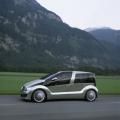 Having tested the water with its A-Class based F-Cell vehicle, Mercedes-Benz is ready for phase two of its fuel-cell research project. At the upcoming Tokyo motor show it will be exhibiting a new, purpose-built fuel cell vehicle, the F 600 Hygenius.
Having tested the water with its A-Class based F-Cell vehicle, Mercedes-Benz is ready for phase two of its fuel-cell research project. At the upcoming Tokyo motor show it will be exhibiting a new, purpose-built fuel cell vehicle, the F 600 Hygenius.
The Hygenius’s fuel-cell delivers electrical oomph to an 85 kilowatt (115 hp) motor, allowing the MPVish Hygenius to travel 100km on just 2.9 litres of fuel, according to Mercedes. That's roughly 100 miles per gallon, if anyone measures hydrogen in gallons.
The car is actually a fuel cell/battery hybrid, with the fuel cell charging the batteries when the car is not accelerating, and the battery then augmenting the fuel cell to give maximum shove when required.
As with petrol/electric hybrids, the Hygenius can run on batteries alone at low speed, and can use regenerative braking to reclaim energy that would otherwise be wasted warming up the braking system.
Mercedes hopes to have a “full production maturity” design in place between 2012 and 2015 – a fairly aggressive schedule according to industry insiders.
Unlike the F-Cell, the Hygenius is also a rolling testbed for other future technologies, both inside and outside the vehicle. These innovations range from electrically heated and cooled cupholders, to cameras that keep a computerised watch on the world outside and stop you opening the door in the path of maniac city-centre cyclists, for example.
It also has a clever head-up display system designed to minimise the effort the driver’s eyeball has to put in, switching focus from the road ahead to dashboard distance:
The images on both high-resolution colour displays in the dashboard are diverted by means of two mirrors before being projected to appear at a point 1.40 metres in front of the driver. This leading-edge virtual display technology from Mercedes-Benz represents a key improvement to driver-fitness safety as it shortens the time required for drivers to switch their gaze from what's taking place on the road far ahead to the close-up instrument cluster display. Scientific studies have confirmed that, with this technology, the driver's eyes do not have to constantly adjust between close and long range so they do not tire as quickly.
Filed under cars and computers



